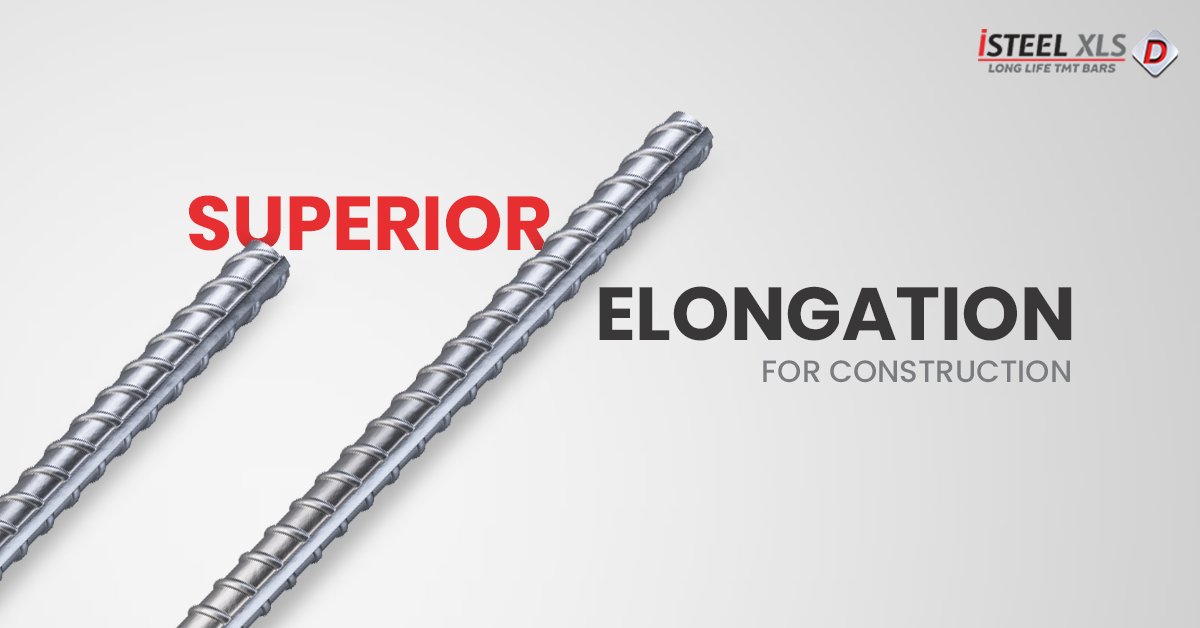Superior Elongation in TMT bars - iSTEEL

- By : admin
- 0 Comments
The Thermo Mechanically Treated (TMT) bar has a lot of characteristics. This iron rod offers superior flexibility, strength, and ductility to iron rods created locally. Additionally, it has a higher tensile strength. A few years ago, HYSD bars were employed by builders for building. However, the structures these bars created quickly encountered several problems. When natural disasters like earthquakes struck, the steel bars were unable to withstand the force and caused an accident.
The scientists discovered that the HYSD bars lacked flexibility and strength. The 550D TMT bars, which are highly robust and earthquake resistant, then arrived.
Construction using TMT bars provide many advantages:
The Construction TMT bars are utilized in many different types; there is no specific construction type where this material is employed. It’s because of its advantages:
- Greater power
- Scope of getting welded
- Higher ductility
- Excellent elongation capability
The Construction TMT bars are less in weight. As a result, transportation becomes inexpensive. TMT bars are used in several different types of structures, not just one. Its exceptional ductility and wide range of elongation are the only reasons it can withstand the weight of such difficult projects. The ability to blend strength and flexibility perfectly is crucial for creating the “sudden load.”
550D or Fe 550D, as defined by IS:1786, is a grade of Thermo Mechanically Treated (TMT) steel bars, with Fe denoting iron. Iron is mostly utilized to create the bars. The letters “D” and “550” stand for ductility and the minimum yield stress, respectively, in MPa (the amount of tensile force required to achieve full elongation). This means that TMT steel bars of grade 550D have a higher percentage of tensile strength and elongation.
Constructions or buildings that need 550D TMT steel bars are those that support big loads. This category includes buildings such as dams, railway bridges, flyovers, stadiums, skyscrapers, airports, industrial structures, windmills, ports, hospitals, tunnels, concrete roadways, malls, and multiplexes.
Because D-grade steel is so resistant to seismic activity, it is more commonly used in earthquake-prone locations. The 550D TMT steel bars reduced carbon, Sulphur, and prosper levels contribute to the steel’s preservation and seismic stress resistance.
The reason for this is that the 550D grade TMT bars manufacturing process produces steel products with a hard outer shield that gives the 550D grade TMT bar the necessary strength and a soft inner core that gives the product the necessary flexibility to withstand the devastating earth-shaking movement during an earthquake.
Flexibility in TMT Bars:
One of the most important characteristics of high-quality TMT bars is flexibility and elongation. TMT bars’ flexibility enables them to support increased loads during disasters like earthquakes and floods. A TMT bar’s ability to withstand the powerful shock waves produced by natural disasters depends on how flexible it is.
This is the rationale behind the widespread usage of TMT bars in modern construction, particularly in earthquake-prone nations like India, China, and Japan.
The finest TMT bars are chosen over other types of steel bars for building projects because they are not only extremely flexible but also have qualities like fire resistance and corrosion resistance.
Thermal processing, which includes compression and rolling of the bars through heat treatment, water quenching, and heating and cooling at various temperatures, is a step in the production of TMT bars.
The steel is often heated to an extremely high temperature when it is rolled through the mills during the whole production process (usually above 1100 degrees Celsius). This is done to reduce the steel’s thickness and give the steel portions their right form.
550D TMT bars are quenched in a controlled atmosphere called a quenching box. Additionally, there is a unique water system that only cools the bar’s surface, leaving the center to retain heat. After that, the surface is heated to complete the self-tempering process.
The TMT bars’ exterior layer becomes harder during this process, but their interior stays pliable. TMT bars acquire flexibility and other unique qualities like high tensile strength and ductility in this way.
Why should TMT bars be flexible?
Building professionals should always select TMT bar versions with high levels of flexibility. When an earthquake occurs nearby, it is quite helpful. Your home’s TMT bars may be able to withstand the unexpected load that results after an earthquake and flood if they are flexible. As a result, there will be no chance of the structures cracking or collapsing.
There is a high chance of earthquakes in nations like China, Japan, Indonesia, India, and Indonesia. Therefore, it is crucial to purchase a structure that can protect you from natural disasters.
The TMT steel grade bar’s exceptional flexibility is a result of another well-known procedure known as the water-spray process, which boosts the tensile strength of the TMT Steel grade bars and makes them readily moldable.
Flexibility Test:For TMT bars, there is a flexibility test known as the “Bending & Re-bending” test. The bars are bent at a 135-degree angle and then boiled for roughly 30 minutes. Later, it is bent again, this time to around 157.50 degrees. The test’s goal is to make sure that the Grade TMT bars have the ideal combination of flexibility and strength.
